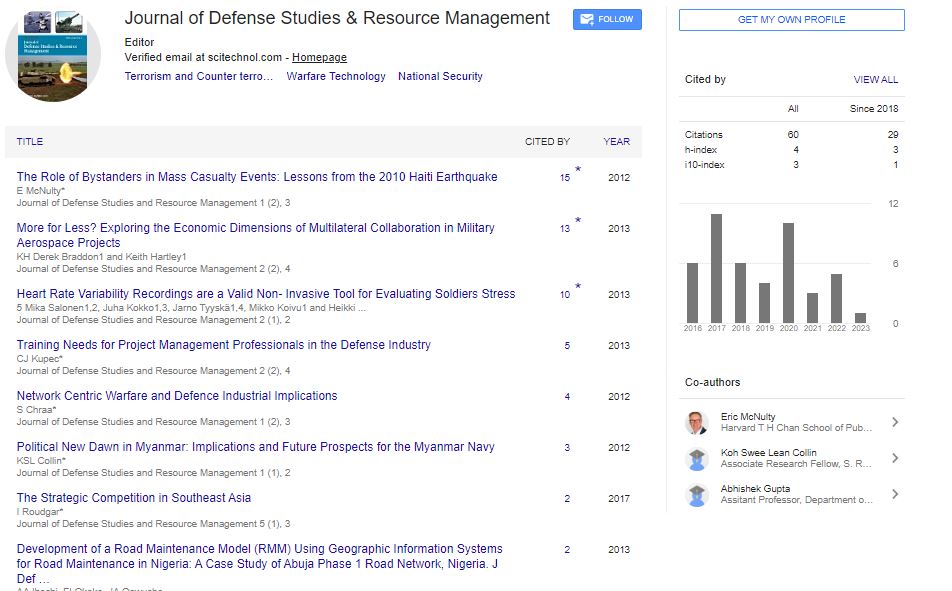Perspective, J Def Stud Resour Manage Vol: 11 Issue: 2
From Development to Deployment: Exploring the Beretta PM12 Submachine Gun's Legacy
Jeffrey Phillips*
1Department of War Studies and Military History, Swedish Defence University, Stockholm, Sweden
*Corresponding Author: Jeffrey Phillips,
Department of War Studies and
Military History, Swedish Defence University, Stockholm, Sweden
E-mail: jp@math.uu.se
Received date: 29 May, 2023, Manuscript No. JDSRM-23-107149;
Editor assigned date: 31 May, 2023, PreQC No. JDSRM-23-107149(PQ);
Reviewed date: 14 June, 2023, QC No. JDSRM-23-107149;
Revised date: 22 June, 2023, Manuscript No. JDSRM-23-107149(R);
Published date: 29 June, 2023, DOI: 10.4172/2324-9315.1000175
Citation: Phillips J (2023) From Development to Deployment: Exploring the Beretta PM12 Submachine Gun's Legacy. J Def Stud Resour Manage 11:2.
Abstract
Description
The Beretta PM12 is a renowned submachine gun that has played a significant role in the firearms industry. Developed by the Italian firearms manufacturer Beretta, the PM12 has a rich history and has been widely used by military, law enforcement, and security forces around the world. This article will delve into the evolution of the PM12, its development process, its applications and advantages, as well as its limitations and disadvantages.
History and Development
The Beretta PM12 was first introduced in the late 1950s as a replacement for the aging MAB Model 38 submachine gun used by the Italian military. The initial design was heavily influenced by the German MP40 and featured a folding stock and an open-bolt design. Over the years, Beretta made several refinements and introduced different variants, including the PM12S, PM12S2, and PM12S3. The PM12's development focused on enhancing reliability, ergonomics, and compactness. It utilized a simple blowback operation, fired from an open bolt, and featured a select-fire option (semi-automatic and fully automatic). Its compact size and lightweight construction made it suitable for close-quarter combat and specialized roles.
Use and Applications
The Beretta PM12 has been adopted by various military, law enforcement, and security agencies worldwide. Its compact design and controllability make it well-suited for urban combat, counter-terrorism operations, and close protection assignments. Special Forces units and SWAT teams appreciate its maneuverability, ease of use, and the ability to engage targets at close range.
Advantages
The PM12's compact size allows for easy handling in tight spaces, making it ideal for urban operations and vehicle crews. Its folding stock further enhances its portability and maneuverability. The PM12 is known for its exceptional reliability, even in adverse conditions. It has proven to be durable and capable of functioning reliably in various environments. With its simple design and intuitive controls, the PM12 is easy to operate and maintain. It has a straightforward disassembly process, making it user-friendly and facilitating quick field stripping for cleaning and maintenance. The PM12 typically utilizes 32-round box magazines, providing a substantial ammunition capacity for a submachine gun. This high-capacity magazine allows for sustained fire during engagements.
Disadvantage
Due to its pistol-calibre ammunition, the PM12 has limited effective range and stopping power compared to rifles or larger-calibre weapons. Its effectiveness diminishes at longer distances. The PM12 can exhibit significant recoil in full-automatic mode, making it challenging to control during sustained fire. Burst or single-shot firing modes are generally preferred for better accuracy. While the PM12 has undergone various improvements over the years, its basic design is rooted in earlier submachine gun designs. It lacks some modern features and advancements found in more recent firearms. The PM12's proprietary magazines can be challenging to find in certain regions or during emergencies, limiting its sustained use.
Conclusion
The Beretta PM12 submachine gun has left a lasting impact on the firearms landscape with its storied history, development process, and widespread utilization. Its compactness, reliability, and ease of use have made it a favoured choice for various tactical scenarios, particularly in urban combat and close-protection missions. The PM12's legacy is further highlighted by its adoption by military, law enforcement, and security agencies worldwide. However, it is important to recognize the limitations and disadvantages of the PM12. Its pistol-calibre ammunition restricts its effective range and stopping power, and its recoil can pose challenges in fully automatic fire. While the PM12 has seen improvements, its design may be considered relatively outdated compared to more modern submachine guns available today. Nevertheless, the Beretta PM12 has earned its place in firearms history and continues to be respected for its contributions to the submachine gun category. It serves as a reminder of the advancements in compact weapon design and the ongoing quest for balance between size, firepower, and manoeuvrability. As firearms technology continues to evolve, the PM12's impact will endure, and its strengths and weaknesses will inform the development of future weapons. Whether in the hands of military personnel or law enforcement officers, the Beretta PM12 remains an emblem of reliable performance and a testament to Beretta's commitment to innovation in the realm of small arms.
 Spanish
Spanish  Chinese
Chinese  Russian
Russian  German
German  French
French  Japanese
Japanese  Portuguese
Portuguese  Hindi
Hindi 